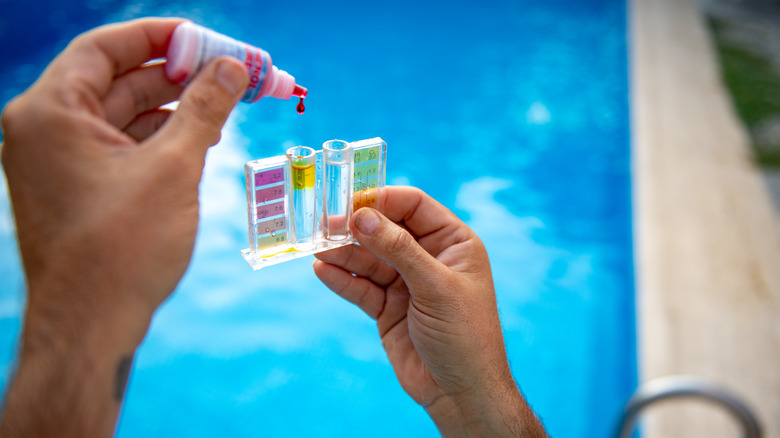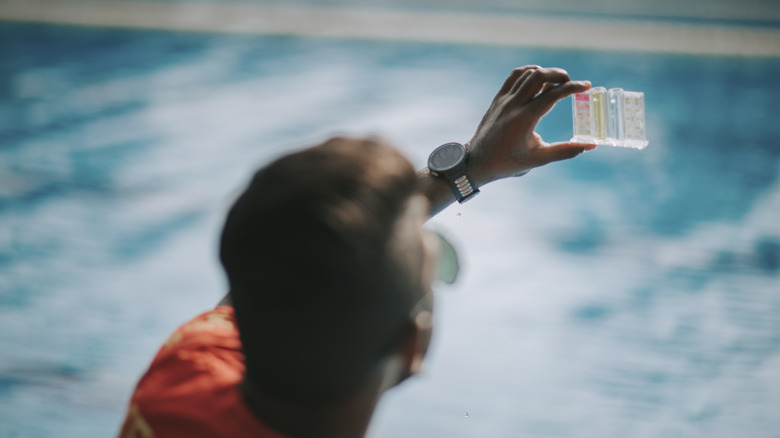Can You Use Vinegar To Lower pH In Your Pool? What You Need To Know
Having a pool is one of the best ways to cool off throughout the hot summer months. Making sure that it's safe to swim in, though, is a delicate balancing act, especially depending on the type of pool you have in your yard. In-ground and above-ground pools function much differently just as a saltwater pool has much different needs than a chemically-maintained pool. To maintain such proper levels, pool chemicals are often used, but some on the Internet have been questioning whether a more gentle solution of using vinegar could successfully do the same. Turning to this method to lower the pH of an alkaline pool may seem like a quick, gentle, and effective solution for homeowners looking for an alternative to sometimes harsh traditional pool chemicals, but, in reality, it may not provide the desired results.
Vinegar, which contains acetic acid, can lower the pH levels of water; however, using it in your pool will produce several consequences. First, typical household vinegar isn't concentrated enough to make a noticeable change in the amount of water a pool contains. In order to lower the pH of an entire pool, a significant amount of vinegar would be required, which would be both expensive and unpleasant to smell or swim in. At the same time, it could also damage pool equipment and promote the growth of algae since it would introduce organic matter into the pool water. Nevertheless, it's best to stick with traditional pool chemicals instead.
Why the pH of your pool is so important
If you have a pool, then you are probably familiar with the weekly water testing to be sure that you and your guests can safely enjoy the cool waters during the hot summer days. Maintaining the pH of your pool to the proper levels — between 7.3 and 7.6 — will allow any swimmers to enjoy the cool waters comfortably without worrying about skin or eye irritation that is known to occur with unbalanced levels. Water that is too alkaline or acidic is unsafe for skin contact, producing burns or rashes, and is ultimately not a great way to keep cool on a hot day.
Moreover, a balanced pH in your pool also ensures that harmful bacteria and algae are unable to survive. This is important for sanitation as chlorine is less effective if the pH deviates too far from the required safe zone on the scale. Chlorine works best at 7.4, so if it drops too low, it may not kill all of the viruses, bacteria, or other pathogens that could be lurking in the water, making it unsafe to swim in as you become susceptible to waterborne illnesses. While your own safety is essential while swimming, so is the integrity of the structure of the pool. A pool with water that's too acidic or alkaline may damage the lining or other structural components that hold the pool and pumps together, requiring costly repairs to fix.
Better methods for lowering the pH of your pool
So while it may be tempting to turn to vinegar, ultimately, the better option is just to stick with traditional chemicals designed to properly regulate a pool's pH, protecting both the swimmers and the pool itself. One common chemical that is often used to help lower a pool's pH is muriatic acid, a diluted form of hydrochloric acid. It's a strong acid that can quickly lower pH levels in pool water, but it should be handled with care as it's highly corrosive and can easily burn your skin. Use safety goggles and gloves when working with this chemical and be sure to follow the manufacturer's guidelines for how to dose the size of your swimming pool properly. What's great about this option is that while it can quickly resolve pH issues, it will also eliminate mold and rust from your pool, too.
Another typical chemical you can use to maintain your pool's pH levels is dry acid. This option is made from sodium bisulfate and is available in a granular form that can be directly added to pool water. It's safer and easier to handle than muriatic acid and works very quickly, allowing you to resume swimming after just four hours with a safe water test. On that note, before and after shocking your pool or adding either pH reducer, it's important to always test the water to determine whether or not it's safe to resume swimming.


